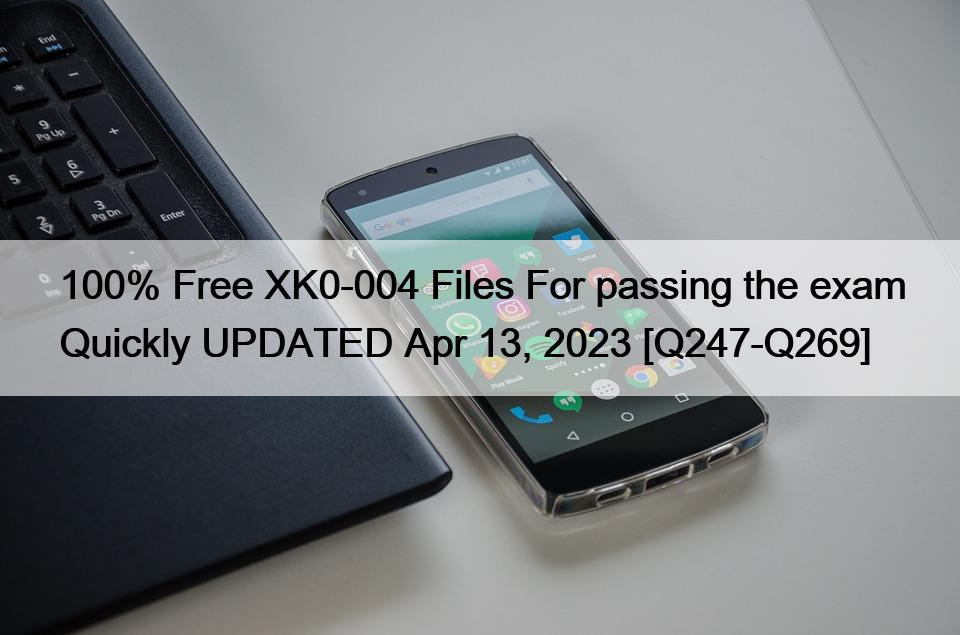100% Free XK0-004 Files For passing the exam Quickly UPDATED Apr 13, 2023
XK0-004 Dumps Questions Study Exam Guide
The benefit in Obtaining the XK0-004 Exam Certification
- There are many companies like Microsoft, CompTIA, Novell, HP, etc. in their own certification tracks are require a CompTIA certification like A+.
- There are many companies and organizations have made CompTIA certifications compulsory for certain positions and several job advertisements list the certification as primary requirements. Certified professionals earn more than non-certified IT professionals in the same job roles.
- Many colleges and universities are giving college credit for students who get CompTIA certifications.
- The big advantage of CompTIA certifications is especially for those candidates who are new to the IT field and they want to increase their own personal confidence. After getting a certification they gain proof that will give them more credibility and determination to advance their career.
How to study the XK0-004 Exam
There are two main types of resources for preparation of certification exams first there are the study guides and the books that are detailed and suitable for building knowledge from ground up then there are video tutorial and lectures that can somehow ease the pain of through study and are comparatively less boring for some candidates yet these demand time and concentration from the learner. Smart Candidates who want to build a solid foundation in all exam topics and related technologies usually combine video lectures with study guides to reap the benefits of both but there is one crucial preparation tool as often overlooked by most candidates the practice exams. Practice exams are built to make students comfortable with the real exam environment. Statistics have shown that most students fail not due to that preparation but due to exam anxiety the fear of the unknown. Dumpleader expert team recommends you to prepare some notes on these topics along with it don’t forget to practice CompTIA XK0-004 exam dumps which have been written by our expert team, Both these will help you a lot to clear this exam with good marks.
CompTIA XK0-004 Exam Syllabus Topics:
| Topic | Details |
|---|---|
Hardware and System Configuration – 21% |
|
| Explain Linux boot process concepts. | 1.Boot loaders
2.Boot options
2.File locations
3.Boot modules and files
4.Kernel panic |
| Given a scenario, install, configure, and monitor kernel modules. | 1.Commands
2.Locations
|
| Given a scenario, configure and verify network connection parameters. | 1.Diagnostic tools
2.Configuration files
3.Bonding
|
| Given a scenario, manage storage in a Linux environment. | 1.Basic partitions
2.File system hierarchy
3.Device mapper
4.Tools
5.Location
6.File system types
|
| Compare and contrast cloud and virtualization concepts and technologies. | 1.Templates
2.Bootstrapping
3.Storage
4.Network considerations
5.Types of hypervisors
|
| Given a scenario, configure localization options. | 1.File locations
2.Commands
3.Environment variables
4.Character sets
|
Systems Operation and Maintenance – 26% |
|
| Given a scenario, conduct software installations, configurations, updates, and removals. | 1.Package types
2.Installation tools
3.Build tools
4.Repositories
5.Acquisition commands
|
| Given a scenario, manage users and groups. | 1.Creation
2.Modification
3.Deletion
4.Queries
5.Quotas
6.Profiles
7.Important files and file contents
|
| Given a scenario, create, modify, and redirect files. | 1.Text editors
2.File readers
3.Output redirection
4.Text processing
5.File and directory operations
|
| Given a scenario, manage services. | 1.Systemd management
2.SysVinit
|
| Summarize and explain server roles. | 1.NTP 2.SSH 3.Web 4.Certificate authority 5.Name server 6.DHCP 7.File servers 8.Authentication server 9.Proxy 10.Logging 11.Containers 12.VPN 13.Monitoring 14.Database 15.Print server 16.Mail server 17.Load balancer 18.Clustering |
| Given a scenario, automate and schedule jobs. | 1.cron 2.at 3.crontab 4.fg 5.bg 6.& 7.kill 8.Ctrl+c 9.Ctrl+z 10.nohup |
| Explain the use and operation of Linux devices. | 1.Types of devices
2.Monitoring and configuration tools
3.File locations
4.Hot pluggable devices
|
| Compare and contrast Linux graphical user interfaces. | 1.Servers
2.GUI
3.Remote desktop
4.Console redirection
5.Accessibility |
Security – 19% |
|
| Given a scenario, apply or acquire the appropriate user and/or group permissions and ownership. | 1.File and directory permissions
2.Context-based permissions
3.Privilege escalation
4.User types
|
| Given a scenario, configure and implement appropriate access and authentication methods. | 1.PAM
2.SSH
3.TTYs
4.PTYs
6.VPN as a client
|
| Summarize security best practices in a Linux environment. | 1.Boot security
2.Additional authentication methods
3.Importance of disabling root login via SSH
5.Chroot jail services
9.Change default ports
11.Importance of enabling SSL/TLS
16.Restrict cron access |
| Given a scenario, implement logging services. | 1.Key file locations
2.Log management
3.lastb |
| Given a scenario, implement and configure Linux firewalls. | 1.Access control lists
2.Technologies
3.IP forwarding
4.Dynamic rule sets
5.Common application firewall configurations
|
| Given a scenario, backup, restore, and compress files. | 1.Archive and restore utilities
2.Compression
3.Backup types
4.Off-site/off-system storage
5.Integrity checks
|
Linux Troubleshooting and Diagnostics – 20% |
|
| Given a scenario, analyze system properties and remediate accordingly. | 1.Network monitoring and configuration
2.Storage monitoring and configuration
3.CPU monitoring and configuration
4.Memory monitoring and configuration
5.Lost root password
|
| Given a scenario, analyze system processes in order to optimize performance. | 1.Process management
|
| Given a scenario, analyze and troubleshoot user issues. | 1.Permissions
2.Access
3.Authentication
4.File creation
5.Insufficient privileges for authorization
6.Environment and shell issues |
| Given a scenario, analyze and troubleshoot application and hardware issues. | 1.SELinux context violations 2.Storage
3.Firewall
4.Permission
5.Dependencies
6.Troubleshooting additional hardware issues
|
Automation and Scripting – 14% |
|
XK0-004 Premium Exam Engine – Download Free PDF Questions: https://www.dumpleader.com/XK0-004_exam.html
